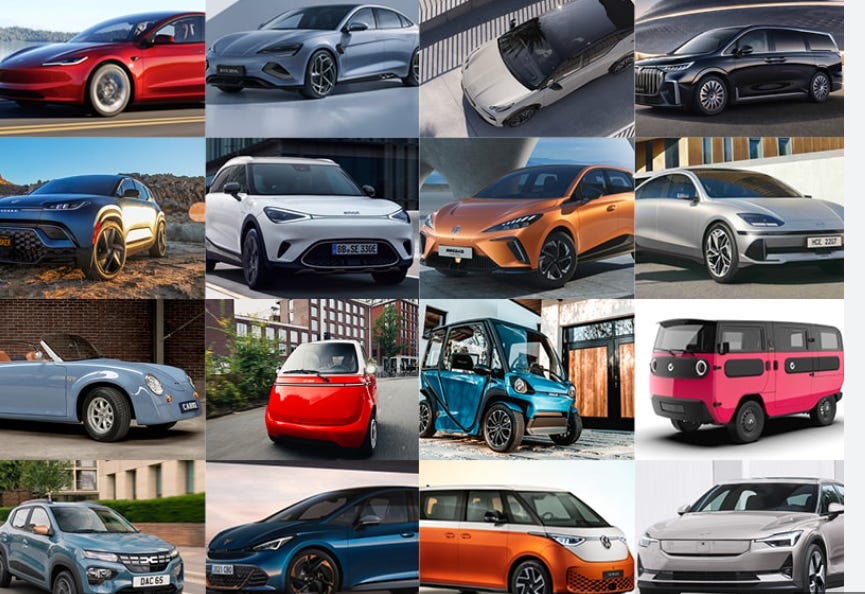Will EU's extra tariffs on Chinese EVs cast a shadow over bilateral economic and trade relations?
The EU tariffs on Chinese electric vehicles went effective from Oct. 30. What are the repercussions of the move? Two Chinese trade experts share their observation.
Greetings and welcome to the latest edition of PekingEnsight! We're thrilled to have you join us once again as we navigate the ever-evolving landscape of the Chinese economy.
The European Union (EU) formally approved the implementation of countervailing duties on Chinese-made electric vehicles (EVs) on Oct. 29 following an investigation that has sparked division within the bloc and drawn criticism from both inside and outside the EU.
Starting on Oct. 30, Chinese electric car manufacturers have to pay additional tariffs of up to 35.3 percent on their exports to the EU, in addition to the bloc's standard 10 percent car import duty, for a period of five years.
The China Chamber of Commerce to the EU expressed strong disappointment with the European Commission's decision to implement this protectionist measure against Chinese EVs, calling the move "inward-looking" and "politically motivated."
In an interview published on Oct. 29 in Bild, a German daily newspaper, the president of the VDA, Germany's main auto industry group, criticized the additional tariffs as "a step backwards for free global trade and thus for prosperity, job preservation and growth in Europe."
The imposition of the tariff follows a vote on the European Commission's proposal for definitive tariffs by the EU's 27 member states on Oct. 4, which resulted in 10 votes in favor, five against and 12 abstentions.
To solve the EV trade dispute, China and the EU have carried out eight rounds of negotiation talks, but failed to reach a consensus.
The good news is that relevant talks remain active. China's Ministry of Commerce said technical teams from both sides are engaged in a new phase of consultations.
The ministry expressed its earnest hope that the EU, as a key trading partner, can collaborate constructively with China to find a mutually beneficial solution as soon as possible. This proactive approach is essential to prevent the escalation of trade frictions, which could have detrimental effects on both economies.
Lin Jian, a spokesperson of China’s Ministry of Foreign Affairs, on Oct. 30 told a regular press briefing that he hopes the European side will continue to advance consultations in a constructive manner, demonstrating sincerity and flexibility in seeking solutions to avoid the escalation of trade frictions.
China has always considered the EU as a comprehensive strategic partner, but the latter's stance towards China has hardened over the last five years.
As the EU seeks to de-risk by reducing reliance on Chinese-made products, it's worth exploring the future direction of China-EU economic and trade relations.
Peking Ensight is honored to speak with two Chinese professors specializing in EU politics and economics who have shared their insights on this issue.
They are 赵永升 Prof. ZHAO Yongsheng from the University of International Business and Economics in Beijing, currently conducting academic research in France, and 丁纯 Prof. DING Chun, director of the Center for European Studies at Fudan University in Shanghai, who also heads the Shanghai Institute for European Studies.
In a nutshell, Prof. ZHAO notes that China and the EU have no fundamental geopolitical conflicts, and bilateral relations can be stable. China's strength in green technologies is a good match for Europe's green agenda. It is advisable for China to increase greenfield investment in the EU to avoid trade barriers, according to him.
Prof. DING argues that both China and the EU should avoid pursuing unilateral victories; instead, they should seek a "second-best" solution to prevent a lose-lose outcome. He also warns that the EU must refrain from addressing trade disputes with a political mindset, as this could lead to a confrontational situation.
The following are key overviews of their viewpoints.
Prof. ZHAO Yongsheng:
1. It is absolutely wrong to accuse China of excessively subsidizing its electric vehicle industry. The phenomenal growth of Chinese electric vehicles is not driven by subsidies or government support; rather, it stems from free competition. When compared to European countries and the United States, China's direct and indirect subsidies are the lowest.
2. If relations between China and the EU were to deteriorate, it would be an unbearable challenge for the EU. China is transitioning from a middle-income country to a high-income country, which means booming demand for high-quality products. Currently, Africa's consumption capacity has not yet fully developed, and although the United States has a high consumption capacity, it has a smaller population than China and its market is relatively saturated. Therefore, China represents a vast market that cannot be overlooked.
For instance, the Chinese penchant for conspicuous consumption has a notable driving effect on the European market for mid-to-high-end products, especially luxury goods. The deterioration of bilateral relations would be too costly for the EU.
3. The EU faces the challenge of keeping pace with the current industrial revolution, which is largely driven by the United States and China. In certain sectors, such as electric vehicles, the EU has fallen behind. For example, France's well-established traditional automotive industry, bolstered by strong sales of fuel-powered cars, lacks the motivation to transform. China's advancement in the automotive sector serves as a prime example of "overtaking on the inside."
4. What the EU should be considering now is not how much tariff to impose on Chinese electric vehicles, but how to catch up with the trends of the times. In the past, the EU was a mentor to China, but the situation has kind of reversed in some areas, and the EU needs to adjust its mindset to adapt to this change and strengthen cooperation with China, as past experience has proved that China is a reliable and trustworthy partner.
5. During the early stages of reform and opening up, China attracted foreign investment by opening its market in exchange for technology through joint ventures. Now, it might be time for Europe to attract technology by similarly opening its market. Increased greenfield investment by China in the EU could be a viable solution to current trade frictions.
6. Prof. Zhao Yongsheng expressed optimism about China-EU relations, which he believes are fundamentally stable. Both sides have a strong incentive to reach consensus. Currently, China and the EU are in a phase of mutual adjustment. There is no intense competition or fundamental geopolitical conflicts between China and the EU. In the future, China-EU cooperation can be all-encompassing, including green technologies and climate change.
Prof. DING Chun:
1. The EU believes that the production capacity of Chinese electric vehicles will primarily be directed toward the European market, given the challenges in other regions, such as high tariffs in the U.S., insufficient charging infrastructure in Africa, and the higher cost of electricity compared to oil in the Middle East. This situation has given the EU considerable bargaining power.
2. The EU justifies its investigation against Chinese-made electric vehicles with the assumption that the substantial subsidies provided by the Chinese government in the early stages have allowed the Chinese electric vehicle industry to rapidly expand and gain a comparative advantage. They say this has distorted market competition.
But, the fact is China already eliminated subsidies for electric vehicles in 2022. Moreover, subsidies are a common practice worldwide for emerging industries, including in the EU, which also has extensive subsidy policies for the electric vehicle sector. The EU's accusations overlook the widespread global practice of subsidizing emerging industries and disregard the fact that China has already ceased subsidizing electric vehicles.
3. As China's manufacturing industry continues to upgrade and its industrial chains become more complete, bilateral trade has gradually shifted from an inter-industry pattern emphasizing complementarity in different sectors to an intra-industry pattern, leading to more trade frictions.
4. If both parties can reach a "second-best" solution, it can at least prevent a lose-lose situation. In the case of electric vehicles, it is commendable that China and the EU continue to seek resolution through consultation and negotiation. This demonstrates that neither side is inclined to resort to decoupling or adopt extreme confrontational measures.
5. There are broad potential and diverse spheres for bilateral cooperation in the field of new energy vehicles. These include collaboration in the R&D of software and hardware technologies, joint efforts to advance the technology of power batteries, cooperative development and manufacturing of new energy supporting facilities, and joint exploration and development of third-party markets to expand the global reach of new energy vehicles.
Additionally, brand building is an important area for cooperation, especially considering that the EU has relatively fewer new energy vehicle brands compared to the numerous options available in China. This presents a significant opportunity for both sides to strengthen collaboration and achieve mutual benefits











